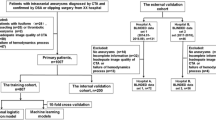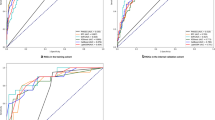Abstract
Purpose
The development of straightforward classification methods is needed to identify unstable aneurysms and rupture risk for clinical use. In this study, we aim to investigate the relative importance of geometrical, hemodynamic and clinical risk factors represented by the PHASES score for predicting aneurysm wall enhancement using several machine-learning (ML) models.
Methods
Nine different ML models were applied to 65 aneurysm cases with 24 predictor variables. ML models were optimized with the training set using tenfold cross-validation with five repeats with the area under the curve (AUC) as cost parameter. Models were validated using the test set. Accuracy being significantly higher (p < 0.05) than the non-information rate (NIR) was used as measure of performance. The relative importance of the predictor variables was determined from a subset of five ML models in which this information was available.
Results
Best-performing ML model was based on gradient boosting (AUC = 0.98). Second best-performing model was based on generalized linear modeling (AUC = 0.80). The size ratio was determined as the dominant predictor for wall enhancement followed by the PHASES score and mean wall shear stress value at the aneurysm wall. Four ML models exhibited a statistically significant higher accuracy (0.79) than the NIR (0.58): random forests, generalized linear modeling, gradient boosting and linear discriminant analysis.
Conclusions
ML models are capable of predicting the relative importance of geometrical, hemodynamic and clinical parameters for aneurysm wall enhancement. Size ratio, PHASES score and mean wall shear stress value at the aneurysm wall are of highest importance when predicting wall enhancement in cerebral aneurysms.



Similar content being viewed by others
References
Skodvin TO, Evju O, Sorteberg A, Isaksen JG (2019) Prerupture intracranial aneurysm morphology in predicting risk of rupture: a matched case-control study. Neurosurgery 84:132–140
Zhu C, Wang X, Degnan AJ, Shi Z, Tian B, Liu Q, Hess C, Saloner D, Lu J (2018) Wall enhancement of intracranial unruptured aneurysm is associated with increased rupture risk and traditional risk factors. Eur Radiol 28:5019–5026
Saalfeld S, Berg P, Niemann A, Luz M, Preim B, Beuing O (2018) Semiautomatic neck curve reconstruction for intracranial aneurysm rupture risk assessment based on morphological parameters. Int J Comput Assist Radiol Surg 13:1781–1793
Lv N, Karmonik C, Chen S, Wang X, Fang Y, Huang Q, Liu J (2018) Relationship between aneurysm wall enhancement in vessel wall magnetic resonance imaging and rupture risk of unruptured intracranial aneurysms. Neurosurgery 84(6):E385–E391
Kleinloog R, de Mul N, Verweij BH, Post JA, Rinkel GJE, Ruigrok YM (2018) Risk factors for intracranial aneurysm rupture: a systematic review. Neurosurgery 82:431–440
Fung C, Mavrakis E, Filis A, Fischer I, Suresh M, Tortora A, Cornelius JF, Bostelmann R, Gralla J, Beck J, Raabe A, Khan MO, Steiger HJ, Petridis AK (2018) Anatomical evaluation of intracranial aneurysm rupture risk in patients with multiple aneurysms. Neurosurg Rev 42(2):539–547
Lindgren AE, Koivisto T, Bjorkman J, von Und Zu M, Fraunberg K Helin, Jaaskelainen JE, Frosen J (2016) Irregular shape of intracranial aneurysm indicates rupture risk irrespective of size in a population-based cohort. Stroke 47:1219–1226
Jiang H, Weng YX, Zhu Y, Shen J, Pan JW, Zhan RY (2016) Patient and aneurysm characteristics associated with rupture risk of multiple intracranial aneurysms in the anterior circulation system. Acta Neurochir (Wien) 158:1367–1375
Kang H, Ji W, Qian Z, Li Y, Jiang C, Wu Z, Wen X, Xu W, Liu A (2015) Aneurysm characteristics associated with the rupture risk of intracranial aneurysms: a self-controlled study. PLoS ONE 10:e0142330
Vlak MH, Rinkel GJ, Greebe P, Algra A (2013) Risk of rupture of an intracranial aneurysm based on patient characteristics: a case-control study. Stroke 44:1256–1259
Amenta PS, Yadla S, Campbell PG, Maltenfort MG, Dey S, Ghosh S, Ali MS, Jallo JI, Tjoumakaris SI, Gonzalez LF, Dumont AS, Rosenwasser RH, Jabbour PM (2012) Analysis of nonmodifiable risk factors for intracranial aneurysm rupture in a large, retrospective cohort. Neurosurgery 70:693–699 (discussion 699–701)
van der Kolk NM, Algra A, Rinkel GJ (2010) Risk of aneurysm rupture at intracranial arterial bifurcations. Cerebrovasc Dis 30:29–35
Ma D, Tremmel M, Paluch RA, Levy EI, Meng H, Mocco J (2010) Size ratio for clinical assessment of intracranial aneurysm rupture risk. Neurol Res 32:482–486
Juvela S, Porras M, Poussa K (2008) Natural history of unruptured intracranial aneurysms: probability of and risk factors for aneurysm rupture. J Neurosurg 108:1052–1060
Dhar S, Tremmel M, Mocco J, Kim M, Yamamoto J, Siddiqui AH, Hopkins LN, Hui M (2008) Morphology parameters for intracranial aneurysm rupture risk assessment. Neurosurgery 63:185–196 (discussion 196–197)
Wermer MJ, van der Schaaf IC, Algra A, Rinkel GJ (2007) Risk of rupture of unruptured intracranial aneurysms in relation to patient and aneurysm characteristics: an updated meta-analysis. Stroke 38:1404–1410
Juvela S, Porras M, Poussa K (2000) Natural history of unruptured intracranial aneurysms: probability of and risk factors for aneurysm rupture. J Neurosurg 93:379–387
Lu G, Huang L, Zhang XL, Wang SZ, Hong Y, Hu Z, Geng DY (2011) Influence of hemodynamic factors on rupture of intracranial aneurysms: patient-specific 3D mirror aneurysms model computational fluid dynamics simulation. AJNR Am J Neuroradiol 32:1255–1261
Qian Y, Takao H, Umezu M, Murayama Y (2011) Risk analysis of unruptured aneurysms using computational fluid dynamics technology: preliminary results. AJNR Am J Neuroradiol 32:1948–1955
Zhang Y, Jing L, Zhang Y, Liu J, Yang X (2016) Low wall shear stress is associated with the rupture of intracranial aneurysm with known rupture point: case report and literature review. BMC Neurol 16:231
Zhang Y, Takao H, Murayama Y, Qian Y (2013) Propose a wall shear stress divergence to estimate the risks of intracranial aneurysm rupture. Sci World J 2013:508131
Wang GX, Gong MF, Zhang D, Lei S, Yin JB, Gong ZL, Wen L (2019) Wall enhancement ratio determined by vessel wall MRI associated with symptomatic intracranial aneurysms. Eur J Radiol 112:88–92
Alexander MD, de Havenon A, Kim SE, Parker DL, McNally JS (2019) Assessment of quantitative methods for enhancement measurement on vessel wall magnetic resonance imaging evaluation of intracranial atherosclerosis. Neuroradiology 61(6):643–650
Hartman JB, Watase H, Sun J, Hippe DS, Kim L, Levitt M, Sekhar L, Balu N, Hatsukami T, Yuan C, Mossa-Basha M (2019) Intracranial aneurysms at higher clinical risk for rupture demonstrate increased wall enhancement and thinning on multicontrast 3D vessel wall MRI. Br J Radiol 92:20180950
Tian B, Toossi S, Eisenmenger L, Faraji F, Ballweber MK, Josephson SA, Haraldsson H, Zhu C, Ahn S, Laub G, Hess C, Saloner D (2018) Visualizing wall enhancement over time in unruptured intracranial aneurysms using 3D vessel wall imaging. J Magn Reson Imaging 50(1):193–200
Edjlali M, Guedon A, Ben Hassen W, Boulouis G, Benzakoun J, Rodriguez-Regent C, Trystram D, Nataf F, Meder JF, Turski P, Oppenheim C, Naggara O (2018) Circumferential thick enhancement at vessel wall MRI has high specificity for intracranial aneurysm instability. Radiology 289:181–187
Takano K, Hida K, Kuwabara Y, Yoshimitsu K (2017) Intracranial arterial wall enhancement using gadolinium-enhanced 3D black-blood T1-weighted imaging. Eur J Radiol 86:13–19
Hu P, Yang Q, Wang DD, Guan SC, Zhang HQ (2016) Wall enhancement on high-resolution magnetic resonance imaging may predict an unsteady state of an intracranial saccular aneurysm. Neuroradiology 58:979–985
Nagahata S, Nagahata M, Obara M, Kondo R, Minagawa N, Sato S, Mouri W, Saito S, Kayama T (2016) Wall enhancement of the intracranial aneurysms revealed by magnetic resonance vessel wall imaging using three-dimensional turbo spin-echo sequence with motion-sensitized driven-equilibrium: a sign of ruptured aneurysm? Clin Neuroradiol 26:277–283
Edjlali M, Gentric JC, Regent-Rodriguez C, Trystram D, Hassen WB, Lion S, Nataf F, Raymond J, Wieben O, Turski P, Meder JF, Oppenheim C, Naggara O (2014) Does aneurysmal wall enhancement on vessel wall MRI help to distinguish stable from unstable intracranial aneurysms? Stroke 45:3704–3706
Aoki S, Shirouzu I, Sasaki Y, Okubo T, Hayashi N, Machida T, Hoshi E, Suzuki K, Funada N, Araki T (1995) Enhancement of the intracranial arterial wall at MR imaging: relationship to cerebral atherosclerosis. Radiology 194:477–481
Lv N, Karmonik C, Chen S, Wang X, Fang Y, Huang Q, Liu J (2020) Wall enhancement, hemodynamics, and morphology in unruptured intracranial aneurysms with high rupture risk. Transl Stroke Res. https://doi.org/10.1007/s12975-020-00782-4
Vergouwen MDI, Backes D, van der Schaaf IC, Hendrikse J, Kleinloog R, Algra A, Rinkel GJE (2019) Gadolinium enhancement of the aneurysm wall in unruptured intracranial aneurysms is associated with an increased risk of aneurysm instability: a follow-up study. AJNR Am J Neuroradiol 40(7):1112–1116. https://doi.org/10.3174/ajnr.A6105 (Epub 2019 Jun 20 PubMed PMID: 31221634)
Matsushige T, Shimonaga K, Ishii D, Sakamoto S, Hosogai M, Hashimoto Y, Kaneko M, Ono C, Mizoue T, Kurisu K (2019) Vessel wall imaging of evolving unruptured intracranial aneurysms. Stroke 50(7):1891–1894. https://doi.org/10.1161/STROKEAHA.119.025245 (Epub 2019 Jun 6 PubMed PMID: 31167619)
Greving JP, Wermer MJ, Brown RD Jr, Morita A, Juvela S, Yonekura M, Ishibashi T, Torner JC, Nakayama T, Rinkel GJ, Algra A (2014) Development of the PHASES score for prediction of risk of rupture of intracranial aneurysms: a pooled analysis of six prospective cohort studies. Lancet Neurol 13:59–66
Karmonik C, Diaz O, Klucznik R, Grossman RG, Zhang YJ, Britz G, Lv N, Huang Q (2015) Quantitative comparison of hemodynamic parameters from steady and transient CFD simulations in cerebral aneurysms with focus on the aneurysm ostium. J Neurointerv Surg 7:367–372
Xiao W, Qi T, He S, Li Z, Ou S, Zhang G, Liu X, Huang Z, Liang F (2018) Low wall shear stress is associated with local aneurysm wall enhancement on high-resolution MR vessel wall imaging. AJNR Am J Neuroradiol 39:2082–2087
Wang GX, Xia C, Liu J, Cui C, Lei S, Gong MF, Wen L, Zhang D (2018) The relationship of arterial wall enhancement ratio on MRI with the degree of inflammation in a rabbit aneurysm model: a pilot study. Acad Radiol 26(10):292–297
Edjlali M, Boulouis G, Derraz I, Ben Hassen W, Rodriguez-Regent C, Trystram D, Meder JF, Oppenheim C, Naggara O (2018) Intracranial aneurysm wall enhancement decreases under anti-inflammatory treatment. Neurology 91:804–805
Kim RJ, Chen EL, Lima JA, Judd RM (1996) Myocardial Gd-DTPA kinetics determine MRI contrast enhancement and reflect the extent and severity of myocardial injury after acute reperfused infarction. Circulation 94:3318–3326
Zhang YN, Zhang YM (2019) Letter: relationship between aneurysm wall enhancement in vessel wall magnetic resonance imaging and rupture risk of unruptured intracranial aneurysms. Neurosurgery 84:E233
Lv N, Karmonik C, Huang Q, Liu J (2019) In reply: relationship between aneurysm wall enhancement in vessel wall magnetic resonance imaging and rupture risk of unruptured intracranial aneurysms. Neurosurgery 84:E234
Dunås T, Holmgren M, Wåhlin A, Malm J, Eklund A (2019) Accuracy of blood flow assessment in cerebral arteries with 4D flow MRI: evaluation with three segmentation methods. J Magn Reson Imaging 50(2):511–518. https://doi.org/10.1002/jmri.26641
Funding
This study was funded by the National Natural Science Foundation of China (Grant Number 81701775) and the National Research and Development Project of Key Chronic Diseases (Grant Number 2016YFC1300700).
Author information
Authors and Affiliations
Corresponding author
Ethics declarations
Conflict of interest
The authors declare that they have no conflict of interest.
Ethical approval
All procedures performed in studies involving human participants were in accordance with the ethical standards of the institutional and/or national research committee and with the 1964 Helsinki declaration and its later amendments or comparable ethical standards.
Informed consent
Informed consent was obtained from all individual participants included in the study.
Data sharing statement
Data are available upon reasonable request.
Additional information
Publisher's Note
Springer Nature remains neutral with regard to jurisdictional claims in published maps and institutional affiliations.
Rights and permissions
About this article
Cite this article
Lv, N., Karmonik, C., Shi, Z. et al. A pilot study using a machine-learning approach of morphological and hemodynamic parameters for predicting aneurysms enhancement. Int J CARS 15, 1313–1321 (2020). https://doi.org/10.1007/s11548-020-02199-8
Received:
Accepted:
Published:
Issue Date:
DOI: https://doi.org/10.1007/s11548-020-02199-8




